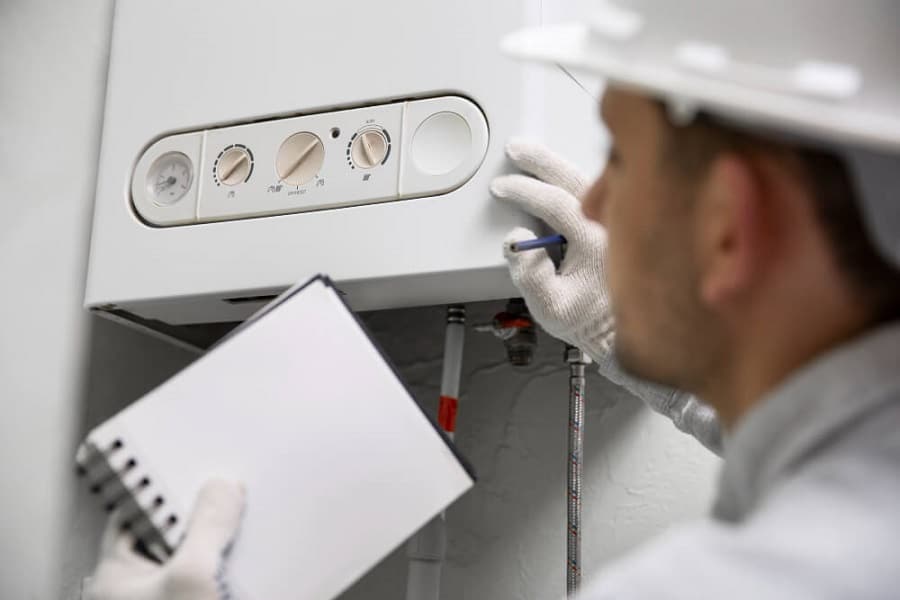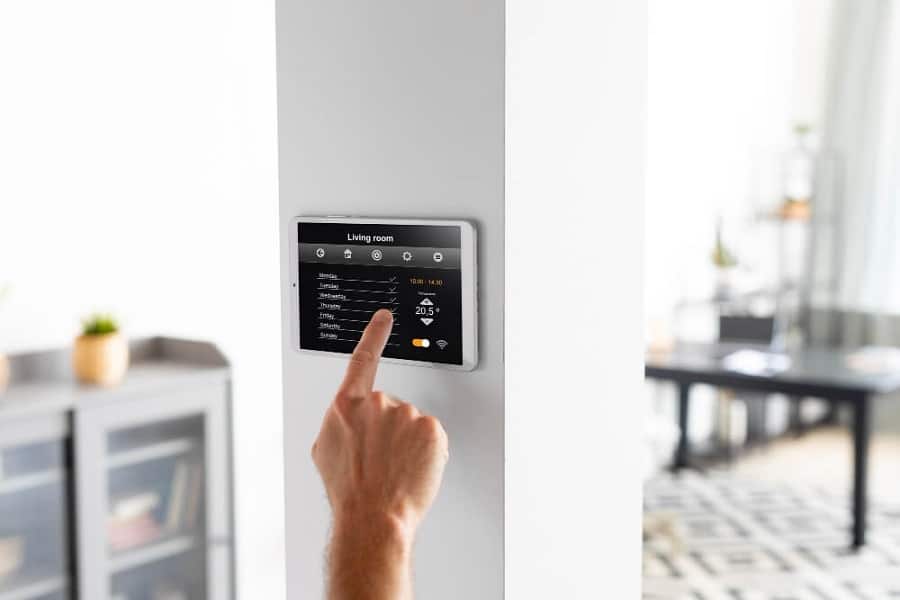Increasing energy efficiency in a UK home is always on a homeowner’s mind. Fortunately, there is a simple yet effective solution on how to better control heating throughout the home – multi-zone heating. This method has long since been a game changer, and allows homeowners to control temperature settings in different rooms around the house, particularly with underfloor heating systems. In this article, we will explore how to add multi-zone heating to a home, by integrating underfloor heating, especially when paired with the right heating controls, to help optimise comfort and energy usage in UK homes.
Table of Contents
What can a multi zone underfloor heating system be used for?
A multi zone underfloor heating system operates with multiple room thermostats, enabling each room to have balanced heating schedules and temperatures. In essence, multi-zone heating divides your home into separate ‘zones’ rather than single zone underfloor heating letting you heat specific sections independently.
For example, you might group the living room and kitchen as one zone, the bedrooms as another, and the bathrooms as yet another. This approach is especially cost-effective during colder months, allowing you to maintain a cosy temperature in frequently used spaces like the living room, while keeping lesser-used rooms, such as bathrooms, slightly cooler.
Understanding Multi-Zone Heating Systems
Multi-zone heating systems operate by controlling the flow of warm water (or electricity) through individual loops. Rather than using a single zone valve, these systems employ wiring centres coupled with actuators.
This setup ensures each underfloor heating zone receives independent control. Meanwhile, traditional radiator and hot water systems maintain their standard control via zone valves.
Why To Use a Multi-Zone Heating System

You should use a multi-zone heating system approach for a multitude of reasons when heating your home, when integrated with underfloor heating systems. Here are our recommended reasons as to why to use multi-zone heating:
- Perfect for both modern and older homes with ducting, as well as those utilising mini-split systems, multi-zone heating solutions offer plenty of benefits.
- Homes with challenging areas to heat or cool can benefit immensely too, as these systems target specific zones without affecting the overall comfort of the entire house.
- For households with varied temperature preferences, multi-zone systems are a boon, allowing individualised temperature settings in different zones, each controlled by its own thermostat.
- If you want to conserve energy and reduce the cost of bills, these systems enable you to control temperatures in frequently used spaces, so that you do not need to adjust the temperature throughout the house.
- If you are looking to heat larger sections of your home with separate controls, multizone tile heating systems are the right choice for you.
Underfloor Heating Room Thermostats
Every zone in an underfloor heating system is governed by a customisable room thermostat, ensuring each space has its distinct time and temperature settings. When any thermostat signals a need for heat, it activates an electronic valve (actuators) located at the manifold’s base. This action prompts your pump to start and triggers your boiler.
Each manifold loop can have separate control settings, usually equating to one loop for each room, though this can vary based on room dimensions.
Are you still unsure about whether underfloor heating is right for you? Check out these benefits of underfloor heating.
Does Multi-Zone Heating Enhance My Home’s Energy Efficiency?
Implementing multi-zone heating can significantly boost your home’s energy efficiency. Given that buildings contribute to global CO2 emissions, enhancing our homes’ efficiency with greener, sustainable energy solutions and minimising energy wastage is crucial for environmental protection.
Zoned heating systems allow homeowners to heat specific areas independently, preventing unnecessary energy consumption. Avoiding the pitfalls of overheating or warming vacant spaces not only ensures a pleasant living environment but also conserves energy, leading to reduced heating expenses.
With underfloor heating installed in your home, you can enjoy better comfort and 40% extra efficiency than those with traditional central heating. If you are unsure about controlling temperatures in your home, we have guidance on what temperature your home should be.
Have you heard about net zero? If not, here is what you need to know about what is net zero.
Using Smart Thermostats For Multi-Zone Heating

For precise heat management across multiple zones of a water or electric underfloor heating system, dedicated room thermostats for each zone are essential. Leveraging the capabilities of smart thermostats can significantly enhance the energy efficiency of a zoned heating system, which can save you energy costs.
Modern smart thermostats come equipped with intuitive touchscreens, such as our Prowarm Pro Digital Thermostat, which enables users to effortlessly set up customised heating schedules. This ensures tailored temperature regulation for every heating zone in your home.
Wireless control systems offer a user-friendly approach to managing water-based underfloor heating. With advanced smart technology, these systems allow homeowners to establish personalised and automated heating schedules across different home areas. For those looking to transition their existing central heating into a multi-zone system, an electrothermic manifold actuator can be fitted onto each radiator, creating distinct zones.
Pairing your smart thermostat with compatible smartphone apps further elevates the control experience. For example, our NovaTherm Universal Gateway Hub is the perfect option to download onto your smartphone from the Apple store or Google Play, suitable for all devices on Apple and Android. Such apps utilise cutting-edge technology to automatically determine the most efficient temperatures for your residence, potentially reducing energy consumption by up to 25%.
If you’re integrating a floor heating system across various sections of your smart home, these apps often provide features to group thermostats collectively, streamlining management.
For renovated homes, here is how to retrofit underfloor heating.
How Underfloor Heating Advances Multi-Zoned Heating
Underfloor heating inherently supports a multi-zone heating strategy and stands out as a more energy-efficient alternative compared to conventional heating methods.
These heating systems employ radiant heat technology, warming rooms from the floor upwards and directly benefiting the occupants. This contrasts with central heating, which primarily heats the air, often leading to considerable energy wastage. With underfloor heating, achieving the desired comfort levels requires less energy, resulting in a significant reduction in both environmental impact and household running costs.
Electric underfloor heating systems are commonly integrated as supplemental heat sources during home renovations. It’s feasible to fit an electric underfloor heating system in a single room to complement your existing heating setup, or to introduce multiple electric systems across the property. Each electric heater can then function as an independent ‘zone’, controlled by its dedicated underfloor heating thermostat.
For those considering underfloor heating as their main heating solution, water-based underfloor systems are ideal for new constructions and extensive home renovations. These wet systems champion the multi-zone heating concept via interconnected ‘circuits’ of heating pipes. These pipes are laid out in loops beneath the floor and then connected to a central manifold, with each distinct circuit acting as a unique heating zone.
For various home renovations, find out how to install underfloor heating in a loft conversion after it has been renovated.
Advantages of Multi-Zone Heating
Having multi-zone heating offers homeowners enhanced control over their heating preferences. You no longer need to worry about keeping your heating consistent in every room in your home. Now, you can enjoy a warm living room while ensuring the bedroom remains cool for a comfortable night’s sleep. Of course, each of these factors are variable and can be changed to be consistent with the irregularities of UK weather.
Moreover, multi-zone heating means you don’t have to sacrifice comfort to economise on heating expenses. By adjusting the heating in specific rooms specific to your needs, you not only contribute positively to the environment but will also notice miraculous savings.
Installing Multi-Zone Heating
Whether it’s a modern home, a renovation or classic-style home, and irrespective of your boiler type, setting up multi-zone heating is straightforward. It typically involves adding the multi-zone heating apparatus to a standard UK wall plate, as well as the potential need for crimp or compression fittings, commonly found in most existing heating controls.
For better results and to immediately enjoy the benefits of multi-zone heating, we advise engaging with one of our recommended, independent professionals for installation, which you can do so by getting a quote with us today.
A Justifiable Investment
Choosing between a single zone smart thermostat and a multi-zone system boils down to your preferences and budget. Both options offer substantial savings, but if you’re willing to invest in a multi-zone system, the long-term benefits will work out better for you.
Regarding return on investment, the recoup period for multi-zone systems aligns closely with that of single zone smart thermostats. Typically, you can expect to earn back the money that you spend on a long-term heating system like multi-zone heating within 2 years, factoring in the enhanced savings associated with multi-zone setups. In the long run, zoned heating proves to be a superior investment, with annual savings for a multi-zone system being double that of single zone alternatives.
And if you are interested about how to integrate your boiler for more energy-efficient heating methods, find out how to add a zone to a boiler.
Multi–Zone vs. Single-Zone Heating: Which is Better?
Both single and multi-zone heating systems come with their distinct advantages. Single zone systems offer a straightforward and efficient heating solution. Given their minimalistic equipment requirements, they often lead to reduced maintenance and fewer repair needs. Opting for a single zone setup can also contribute to a smaller carbon footprint, thanks to lower energy consumption and fewer manufacturing demands.
Conversely, multi-zone systems, once set up, typically result in lower operational costs since they target specific areas for heating or cooling. This setup grants homeowners stable control over their home’s climate, either through a centralised remote system or individual control panels in each room. For bigger UK homes that might otherwise rely on several single zone systems, a multi-zone approach reduces the need for multiple external units. Of course, adding insulation boards to either your multi-zone or single-zone heating will also help when it comes to keeping heat in the home, and will reduce heat loss in homes.
Control Home Heating with Multi-Zone Heating Systems
For those that wish to improve the heating and energy efficiency in their homes, multi-zone heating systems are the right option for you. No matter whether you live alone, or with a family, maintaining a balance in temperatures across every room in your home will be beneficial for you and your occupants.
FAQs
Is multi-zone heating worth it?
Yes, multi-zone heating is worth it for several reasons:
Energy Savings: By only heating the rooms you’re using, you can save on energy costs. Instead of heating the entire house, you can focus on specific zones, reducing energy consumption.
Increased Comfort: Multi-zone heating allows for personalised temperature settings for different rooms. This means that each member of the household can enjoy their preferred temperature in their respective rooms.
Efficiency: Modern multi-zone systems are designed to be highly efficient, further reducing energy bills and environmental impact.
Flexibility: These systems offer the flexibility to adjust heating based on the time of day, occupancy, or specific events, ensuring optimal comfort.
What is a 3 zone heating system?
A 3 zone heating system divides a home into three separate heating areas or zones. Each zone can be heated independently, allowing for different temperature settings based on the preferences or needs of that area. For instance, one zone could be the ground floor, the second zone the upper floor, and the third zone the basement. Each zone will have its own thermostat for precise temperature control. This setup provides flexibility, energy savings, and enhanced comfort by allowing homeowners to heat specific areas of their home as needed.
How do you control multi-heating zones?
Multiple heating zones are controlled using thermostats and control panels:
Thermostats: Each zone will have its own thermostat, allowing for individual temperature settings. Modern thermostats can be programmable or even “smart,” enabling schedules, remote control via smartphones, and integration with home automation systems.
Control Panels: These are central units that manage the operation of the heating system. They ensure that each zone receives the right amount of heat based on the thermostat settings. Some systems also allow for central control, where a homeowner can adjust all zones from a single panel or app.
Sources
Viessmann (2022) How to Add a Zone to a Boiler. Viessman. [online] Available at: https://www.viessmann.co.uk/en/heating-advice/boilers/add-a-zone-to-a-boiler.html [accessed 18/09/23]
